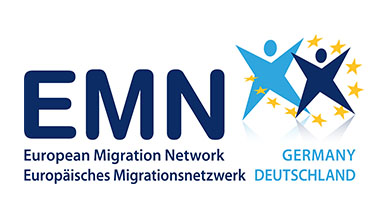The changing influx of asylum seekers in 2014-2016: Germany's response ,
 Source: BAMF
Source: BAMF
The study provides an overview on measures taken in Germany in response to challenges experienced due to the changing influx of asylum seekers in the years 2014 to 2016, from border control to the end of the asylum procedure.
From 2014 to June 2017 approximately 1.5 million asylum seekers arrived in Germany, the vast majority of new arrivals taking place between July 2015 and February 2016. The large number of refugees arriving in Germany in a comparatively short space of time placed a huge strain on several levels such as accommodation, the asylum procedure or the access to integration courses.
Phase of increase of newly arriving asylum seekers
In a first step, the study describes developments in asylum policy, which took place on national but also on EU and third-country level. This comprises inter alia the closing of the border along the Balkan route, the EU-Turkey Statement, the EU relocation programme, border control cooperations with EU Member States as well as support of the European Border and Coast Guard Agency (Frontex) particularly by the Federal German Police.
Measures initiated to cope with the challenges of the changing influx
The situation ultimately triggered dozens of nationwide, hundreds of regional and thousands of local measures, responses and initiatives by state and non-state actors to ease the burden and safeguard orderly and reliable procedures and reception processes. The documentation will focus on the period covering the arrival of asylum seekers in Germany right up to completion of the asylum procedure, with a distinction being made between eight subject areas: border control, accommodation, wider reception services, registration process, asylum procedure, infrastructure and personnel, law enforcement and integration measures for asylum applicants. Subsequently, 100 measures are outlined which shall provide with a brought overview. These include, inter alia, capacity-building in relation to control structures, the digitization of administrative procedures, coordinators for volunteers, earlier access to the labour market for asylum seekers from specific countries of origin, as well as restrictive measures for asylum seekers from safe countries of origin and limiting family reunification for beneficiaries of subsidiary protection.
Phase of relative decline of newly arriving asylum seekers
Even though the number of newly arrived asylum seekers began to fall in Germany from the spring of 2016 onwards, the strong influx continued right into 2017 for many of the subject areas under review owing to the downstream process steps involved and the backlog that ensued. These and some other areas were marked by the consolidation of processes, the stabilisation of newly-created structures, the easing of the burden on staff and volunteers, the standardisation of procedures, the (re)-introduction of quality standards, the provision of follow-up training for staff and the intensification of information sharing among the individual actors.
The way forward – future preparedness
Many of the actors learned initial lessons from the experience gained in recent years. This means they should be better equipped to cope if Germany were to experience another increase in asylum seekers in future. As such, some of the planned measures were aimed at the refunctioning and flexibilisation of existing structures and processes (e.g. "flexible authority"), whereas others were aimed at creating new structures, processes and procuring new equipment (e.g. digitisation of processes involved in the asylum procedure).
Working Paper 79 was authored as part of the European Migration Network (EMN).
The study was drawn up by: Janne Grote
